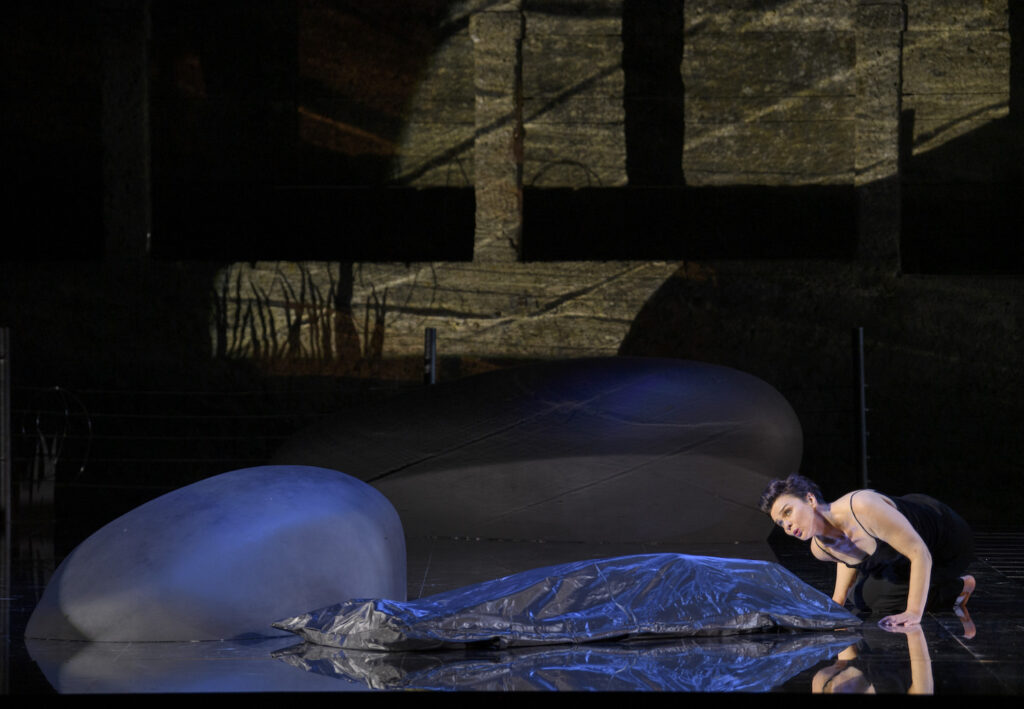A concoction imagined by American stage director Peter Sellars and Finnish conductor Esa-Pekka Salonen. It is three orchestral masterpieces, fused, that host an abstract theater action — a body bag is thrown onto the stage, and then pulled off the stage.
The Vienna Philharmonic Orchestra with conductor Salonen is however the focal point of the exercise, delving deftly into Schönberg’s modernist masterpiece Erwartung (Expectation) (1909) and exquisitely coloring Mahler’s “Der Abschied” (Farewell) from Das Lied von der Erde (1909). These two substantial works, each about one half hour, were bridged by Anton Webern’s pointillist Five Pieces for Orchestra (1913), about six minutes of music.
The title of the resulting pastiche, One Morning Turns into an Eternity, comes from an American translation of a poem by thr 8th century Chinese poet Wang Wei. An integral part of this Peter Sellars pastiche exercise is the synopsis — story lines created by Mr. Sellars that imagine Erwartung as a “Reality” — a political revolutionist obsessing over the body of her martyred lover — and rarify Der Abschied into a personal journey into death, a “Vision” of death that will achieve Nirvana.
It is a florid read.

Lithuanian diva soprano Ausrine Stundyte delivered the Erwartung poem. Mme. Stundyte is an intense artist of truly expressionist proportion (her program bio points out that she often works with stage directors Bieito, Warlikowski and Tcherniakov). As the Erwartung voice she embodied high operatic suffering in truly operatic stances. She did not wear the Sellars overlay of cultural vulnerability that is this director’s ethos, and his muse.
Schönberg’s Erwartung is both athematic and atonal, and of great rhythmic complexity. Esa-Pekka Salonen, one of the world’s fine conductors, led an excellent, if cold performance of the Schönberg’s orchestral score. It is evidently not possible, or musically practical for this (or any) maestro to know and participate in the poem as it unfolds on stage, and to conduct the orchestra at the same time. As it was the pit and stage were separate worlds.
The Sellars / Salonen One Morning Turns into an Eternity was as much a spectacle as it was a musical event. Created by long standing Peter Sellars collaborators George Tsypin (sets) and Joseph F. ingalls (lights), the production was six, extreme stage left, metallically collaged (maybe abstracted Chinese letters) columns that revolved from time to time. Their silver finish reflected the strong shots of blue, red and white color that burst through and upon them from time to time.
The big-effects lighting included grayish, abstract rays of light and other images as dim projections onto the huge scrims covering the gallery carved cliff face that is the massive back wall of the Felsenreitschule, and onto scrims spanning the ceiling of the Riding School’s enormous stage. The flute solos of Der Abschied were performed from a tiny, purple lighted place way up in the left corner of the back wall’s upper galleries.
The four costumes of the production were the work of Sellars collaborator Camille Assaf. The body bag purveyors wore casual street wear and white sneakers, the Erwartung voice was in a simple black jumpsuit, the Der Abschied voice wore a casual green dress/gown.

Singapore born, American trained mezzo-soprano Fleur Barron, the Mahler voice, is an artist solidly in the Peter Sellars mode — an “alternative” operatic presence. As a concert singer Mlle. Barron has much high level experience with the Mahler orchestral song cycles — as well she was the mother in the Peter Sellars / Esa-Pekka Salonen semi-staged Adriana Mater (Saariaho) in San Francisco. Of a rich, lyric mezzo voice Mlle. Barron is an accomplished technician, making this dark toned, colorfully laden Mahler song ingratiatingly present.
This last song of Das Lied von der Erde ends with many repetitions of the German word “ewig” (forever) leading it to a final, quite mystical musical atmosphere.
Der Abschied is rhythmically abstract, its voice alternating in cadenzas with solo instruments. There is no discernible tempo and no perceivable musical structure, leaving it to the conductor to find the elusive moods and colors that Mahler suggests — it is a well-known conducting challenge. Maestro Salonen did indeed make time stand still, portraying Mahler’s mystery of a death becoming one with the eternity once felt as a property of the natural world.
Michael Milenski
Felsenreitschule, Salzburg, Austria, August 15, 2025
All photos copyright Ruth Walz, courtesy of the Salzburg Festival